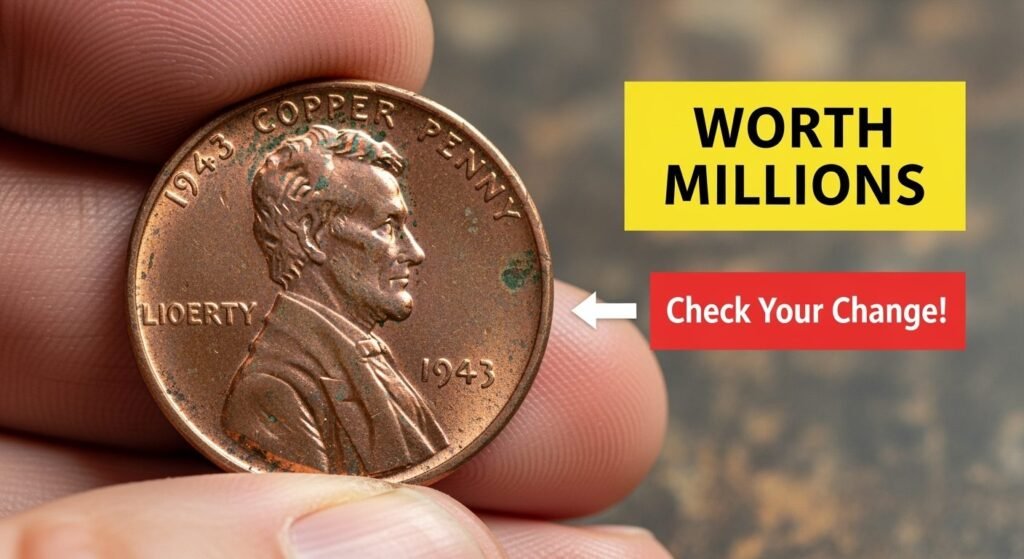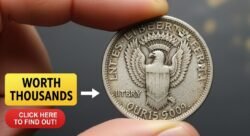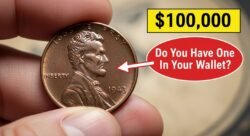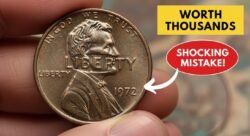1943 Copper Penny: Have you ever wondered if there might be a fortune hiding in your pocket change? I’m always fascinated by those rare coin stories where someone discovers an incredible treasure in their spare change jar. One of the most valuable coins you could possibly find is the legendary 1943 copper penny. While most pennies minted in 1943 were made of steel due to wartime copper conservation, a tiny handful of copper versions were accidentally created. These rare mistakes are now worth millions of dollars to collectors. Today, I want to share everything you need to know about this extraordinary coin and why you should check your change carefully.

What Makes the 1943 Copper Penny So Valuable?
The 1943 copper penny is exceptionally valuable because it simply wasn’t supposed to exist. During World War II, copper was designated as a strategic metal needed for the war effort, primarily for ammunition shell casings. The U.S. Mint was directed to produce pennies from zinc-coated steel instead. However, it’s believed that a few copper penny blanks from 1942 remained in the presses and were struck with the 1943 dies. Only about 20-40 authentic 1943 copper pennies are known to exist today, making them incredibly rare. Their scarcity, combined with their fascinating historical context and the story of their accidental creation, has driven their value into the millions. One specimen sold at auction for over $1.7 million in 2010, making the 1943 copper penny one of the most valuable small coins in existence.
How to Identify an Authentic 1943 Copper Penny
Identifying a genuine 1943 copper penny requires careful examination. First, check the date to confirm it’s actually 1943. Next, test it with a magnet – a real copper penny won’t stick, while the common steel pennies from that year will. Authentic 1943 copper pennies weigh approximately 3.11 grams and have the same copper color as other pennies from the 1940s (though they may be darkened with age). Be extremely cautious, as there are many counterfeits in circulation. Some fraudsters plate steel 1943 pennies with copper, while others alter the date on 1948 pennies. The most reliable verification comes from professional grading services like PCGS or NGC. If you believe you’ve found a 1943 copper penny, I recommend having it authenticated by experts before getting too excited about your potential windfall.
Why Collectors Pay Millions for This Coin
The astronomical value of the 1943 copper penny stems from several factors that drive serious collectors to pay millions. First, there’s the extreme rarity – with fewer than 40 confirmed examples, it’s one of the scarcest U.S. coins of the 20th century. Second, there’s the historical significance tied to World War II and America’s wartime production efforts. Third, there’s the human element of the story – these weren’t deliberately made rarities but genuine mistakes that escaped into circulation. Finally, there’s the enduring mystique that has built up around these coins over decades. The 1943 copper penny has become something of a numismatic holy grail, featured in countless articles, books, and television segments. This combination of rarity, historical importance, and cultural significance creates the perfect storm for high values. Even in circulated condition, a genuine 1943 copper penny would likely sell for hundreds of thousands of dollars.
| Mint Location | Estimated Quantity |
|---|---|
| Philadelphia | 10-15 examples |
| San Francisco | 6 examples |
| Denver | 1-2 examples |
When and Where These Pennies Might Be Found
While most authenticated 1943 copper pennies have already been discovered, there’s always the possibility that more exist in circulation or in old collections. These coins would most likely be found in penny collections assembled in the 1940s and 1950s, before their extreme value was widely known. Family coin collections passed down through generations are potential sources, especially those belonging to people who worked at mints or had connections to the coin production process. Old penny rolls that have remained unopened since the 1940s could potentially contain these treasures. Bank vaults, forgotten safety deposit boxes, and estate sales occasionally yield surprising numismatic discoveries. Though the chances of finding one in everyday pocket change today are extremely slim, it’s not impossible – which is why the 1943 copper penny continues to inspire coin collectors and treasure hunters to check their change carefully.
A Lucky Discovery
One of the most famous 1943 copper penny stories involves a 16-year-old boy named Don Lutes Jr. In 1947, he received a strange copper-colored 1943 penny in his school cafeteria change. Despite taking it to the U.S. Treasury, who incorrectly told him it was impossible for such a coin to exist, Lutes kept the penny his entire life. Only after his death in 2018 was the penny auctioned, selling for $204,000. His discovery, made simply through receiving change for his school lunch, demonstrates why the 1943 copper penny continues to captivate the imagination of collectors and casual coin handlers alike.




